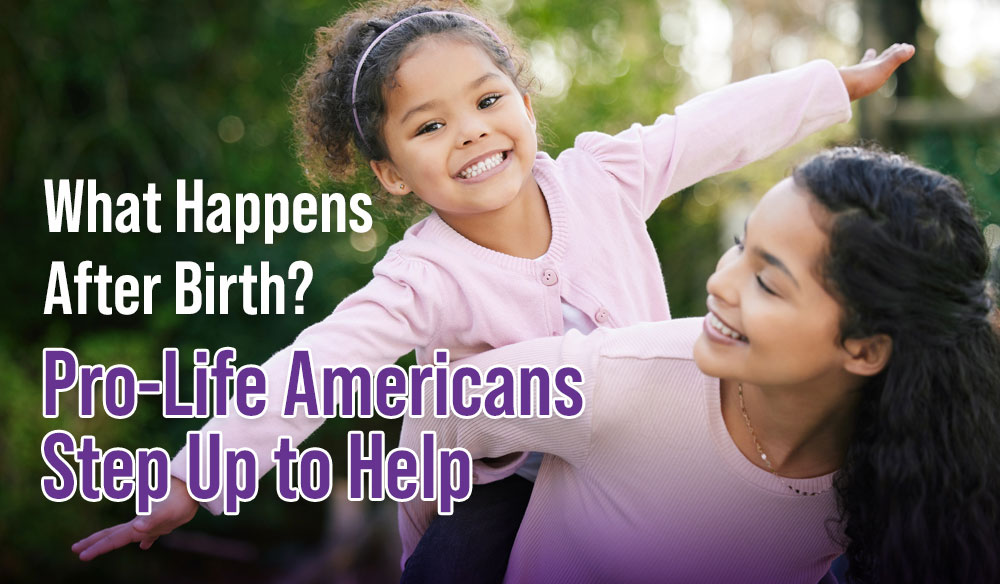What Happens After Birth? Pro-Life Americans Step Up to Help
I like to think that one of the early pro-lifers was Bithiah.
That may or may not be her real name, but that’s what they called this Egyptian princess in Cecil B. DeMille’s big-screen epic, The Ten Commandments. Bithiah was Pharoah’s daughter who spotted little Moses nestled in a basket among the reeds in the Nile. Though the Bible doesn’t share her name, it does reveal that she knew this little basket-boat held a Hebrew baby. With that knowledge, she also would’ve realized that he was supposed to be killed per her dad’s mandate.
She was drawn to this little life – chose mercy – and decided to raise baby Moses as her own.
She’s a great example of how the Pro-Life Movement extends beyond birth. It’s about people – of all ages, ethnicities, backgrounds, abilities, and circumstances – and us – seeking how we can help them live and embrace life.
Fake News
The Pro-Life Movement has often been smeared by those who accuse us of being “pro-birth” not “pro-life.” Detractors claim that our zeal for life ends once we convince a woman to deliver her little one. They contend that we aren’t willing to help when that young mom is faced with desperate needs to find work, a place to stay, food, or diapers. Of course, they are simply making this up, but this media-driven narrative has a good deal of traction.
Do a Google search of Crisis Pregnancy Centers. You’ll find a web page hosted by Planned Parenthood called “Crisis Pregnancy Centers – What to Know and How to Spot Them.” They slander God’s work in these centers, asserting that they are “run by anti-abortion activists who have a shady, harmful agenda; to scare, shame, or pressure you out of getting an abortion, and to tell lies about abortion, birth control, and sexual health.” 1
Wow. Not even a little true.
Pro-Life is Pro-Everybody
The truth is about a thousand miles from Planned Parenthood’s lies, which they have come to be known for.
Crisis Pregnancy Centers (CPCs) come alongside hurting, scared, and confused moms who are facing terribly painful circumstances with an unplanned pregnancy. These volunteers and professionals seek to support these women in various ways, both during the pregnancy and after the little one is born.
To offer a specific example, we’ll use Life Network in Colorado. They provide warm and welcoming guidance to all who come through their doors. Each mom and dad are given clear information about making a choice to parent, to create an adoption plan, or what happens if they do seek an abortion elsewhere. The options are explained honestly, along with the implications of each.
Colorado moms and dads can receive parent coaching sessions until the child is two years old. They can also earn “baby bucks” to be used in Life Network’s store for baby clothes, car seats, cribs, and other needed items. Additionally, they have a program, Bridges of Hope, to support post-abortive moms who are grieving that choice.2
Other CPCs around the country offer help with housing, employment, groceries, counseling, and more. And, given the overturning of Roe v. Wade, many organizations have recognized the need to ramp up ongoing support for these children and their moms.
According to a 2020 study, there are 3,000 pregnancy centers in the US, with 8 in 10 of them offering free ultrasounds. They offer free pregnancy tests and consultations, some have STD testing, and many offer parenting and prenatal education. Most offer material assistance, including diapers, clothes, strollers, car seats, and other supplies.
Together, they employ around 15,000 paid staff, with a quarter of those licensed medical professionals and more than 50,000 volunteers, with more than a tenth holding medical licenses.
Overall, these centers have an extremely high client satisfaction rate. Care Net, one of the nation’s largest networks of pregnancy centers, averages over 99% positive ratings, as compiled from client surveys. This includes around 2100 centers.3
Pro-Life is Pro-Rescue
Babies have been in peril throughout history. Even as Bithiah chose life for a little Hebrew boy, countless others were thrown to their death in the Nile.
Beyond Pharoah’s barbarism, babies have had it rough, with thousands abandoned, drowned, or left to perish in the elements for a variety of reasons. In our own country, stories of babies found in toilets, closets, or dumpsters reveal a frightening problem. Because of these tragic abandonments, solutions have been sought to give desperate birth moms the chance to relinquish their babies – anonymously.
Hoping to provide a strategy after learning of a shocking number of dead babies in the Tiber River in Rome, Pope Innocent legalized “foundling wheels” in 1198. These were small revolving compartments built into the walls of some churches and convents. These allowed a mother to anonymously place her baby inside if she could not care for the little one rather than abandoning it elsewhere. A bell would alert priests or nuns to retrieve the child, and they would care for it while working to arrange for adoption or admission to an orphanage.
More recently, Baby Boxes have popped up in a number of countries in Africa, Europe, Asia, and the US. The Drop Box (2015), a Fathom Event movie, documented Pastor Lee’s baby box in South Korea and the life-saving work he and his wife did as they welcomed and tirelessly cared for numerous disabled and abandoned children left there.
The US has its own heroes addressing the same tragic issue of abandonment. We had the pleasure of getting to know more about the life-saving efforts of Monica Kelsey and her organization, Safe Haven Baby Boxes, when we spoke to her on this week’s podcast. They have nearly 200 baby boxes in 15 states and plenty of stories to go along with them!
Pro-Life is Pro-Child
Did you know that the average age a child enters foster care is six, and there are nearly 400,000 in the system?
A growing number of pro-life advocates and organizations have made strides to help facilitate interest in foster parenting. Most notably, Focus on the Family, a major player in the pro-life arena with their Option Ultrasound Program and streaming See Life events, is also dedicated to work in adoption and foster care.
Their initiative, Wait No More, champions kids and families finding each other. They host events educating audiences about the need for foster parents and providing tools to get started with the process. Additionally, they focus on engaging others who may not be ready to parent but can become part of a support system for foster families.
Pro-Life is for Every Stage of Life
Do you remember the controversial death of Terri Schiavo? In case you were too young to recall it, she was a young woman who collapsed suddenly in 1990, sustaining a brain injury that left her devastatingly disabled, in a persistent vegetative state, not in a coma – but not able to communicate or help herself in any way.
Fifteen years later, the husband petitioned the court to have Terri’s feeding tube removed so that she would pass away. His claim was that she would not want to continue living this way. Her parents tried desperately to block his efforts, and a firestorm of public, legal, and personal emotion swept across the country. Terri’s husband ultimately won the battle against her parents’ desire to care for their daughter, and the nation collectively held its breath as she slowly dehydrated and starved to death over an agonizing 13 days.
Little did we know then, but this fateful decision would have ripple effects over time.
The idea of assisted suicide, or “compassionate” measures to help someone end their suffering, became more trendy, and today, Canadian society has gone all-in on helping their citizens die.
Assisted suicide has become a significant part of Canadian medicine, with more than 13,000 euthanized in 2022. That number has been growing exponentially every year, with some saying the 2023 death count may be around 16,000. In fact, a study projects that by 2034, death by doctor through Canada’s euthanasia program will account for 10% of the deaths in that nation.4
As shocking as Canada’s reckless disregard for life is, we should point out that in the US, assisted suicide is legal in ten states and the District of Columbia.
Meanwhile, two young women from the Netherlands, Jolanda Fun (34) and Zoraya ter Beek (28), both physically healthy, have decided to seek euthanasia since it has been legal there since 2002. Both have depression struggles; however, both also have family and loved ones. Both had questionable counselors. One therapist mentioned suicide as a viable option, and the other informed his young client that “It’s never [going to] get better.” 5
This anti-life trend is frightening, especially as stories of abuses have emerged, with medical staff sometimes pressuring a patient to make this irreversible choice.6
It’s not hard to imagine an elderly patient having someone gently explain that with their condition, they are putting a huge financial burden on their children and grandchildren. That despicably smooth and compassionate-sounding voice explains the option to end one’s suffering–thus relieving the family. Advocates can claim that it doesn’t happen; however, it is certainly a possibility. One we dare not ignore.
This is a pro-life tragedy unfolding around the world. One for which we haven’t found an apt solution other than to trumpet the value of every life in the hopes of winning hearts and minds – and returning society to a clear understanding of the sanctity of our God-given gift of life.
The Pro-Life Movement is clearly NOT the one-trick pony it’s often made out to be. Life is a sweeping issue that encompasses us all. We must pray, speak, share posts, and care deeply for everyone as we hold to this truth: every life is precious, unique, and sacred – from conception until natural death.
3 Lozier Institute Pregnancy Center Study
6Daily Citizen/Focus on the Family
***




